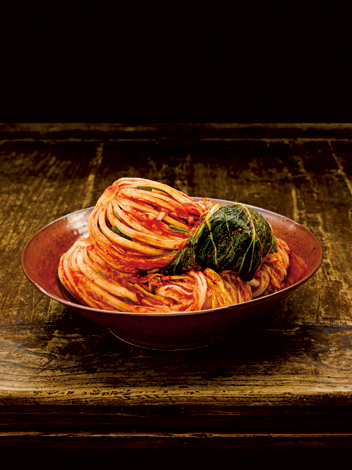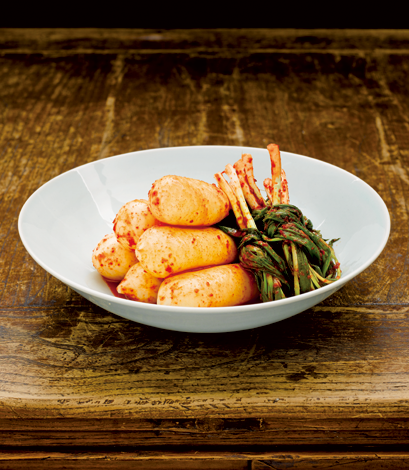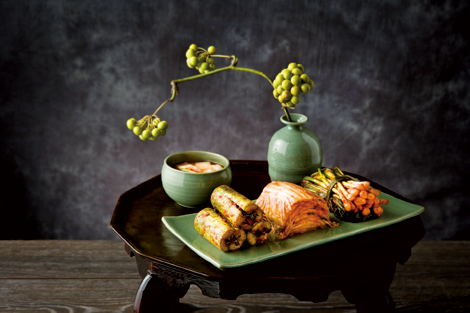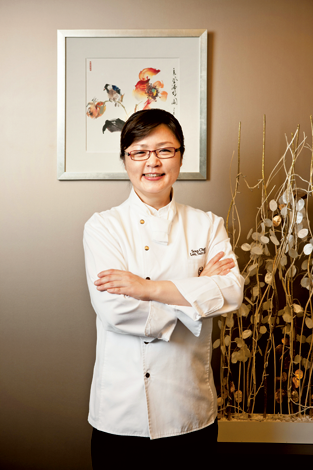I tasted kimchi for the first time in Manila. It was forced on me by a friend, Kathy, whose Korean mother had started a small business in the mid-1970s, specialising in the home-made fermented cabbage delicacy. Frustrated that none of the local supermarkets carried the stuff, Kathy’s mum decided to whip up her own kimchi, and a successful kitchen enterprise was born.
It was love at first crunch – the bracing, tangy pickle roused my taste buds and appetite to such a degree I consumed – with lashings of Coca-Cola – practically the entire contents of the medium-sized Tupperware that Kathy had brought. Until today, there is always a full jar or bulging packet of kimchi nestled in my refrigerator, and when I go for Korean cuisine, which is at least once a month, I invariably ask for seconds of the all-too-small saucer of kimchi that accompanies a set meal.

Baechu kimchi
If you thought I was obsessed, I’m just taking my cue from the Korean people. For them, kimchi is not only their national dish, it’s also been the object of official policy and scientific study. Did you know that one of the government’s goals is to advocate the “globalisation” of kimchi, that there are institutions solely dedicated to promoting the pickling process, such as the Kimchi Field Museum at the COEX Mall and the Food & Culture Academy in downtown Seoul?
And did you expect the first Korean, Yi So-yeon, who blasted off in a Russian Soyuz spacecraft in 2008, to last a week in the International Space Station without his comfort food? Fortunately for the high-flying scientist, the Korea Atomic Research Institute had been running long-term experiments to develop space-friendly kimchi and other traditional treats such as ramyeon and fermented bean soup. Despite the project’s great cost, the scientists had to eradicate bacteria from the kimchi lest cosmic rays mutate it into something harmful. Just like a schoolkid going off with lunch made by mum, Yi was indeed well fortified.

Chonggak kimchi
Various theories about the origins of kimchi abound, all of them highly plausible. Daniel Gray, food expert, author and partner in O’ngo Food Communications, believes it surfaced during the Shilla Dynasty (57 BC-935 AD) and caught on since Buddhism, which was the prevalent religion, promoted a vegetarian lifestyle. He adds: “Rice has always figured prominently on the table, and a long time ago since Koreans didn’t have a lot of food, the main dish was rice. But to eat only rice was considered not healthy or balanced, and they accompanied it with tiny dishes of kimchi, some other vegetables and fermented fish.”
The spicy cabbage kimchi – arguably the most familiar to foreign visitors of the 200 known types – came about when the Portuguese missionaries arrived in the 1700s, carrying chilli peppers with them. “There are really a lot of varieties of kimchi,” explains Gray, whose company aims to use Korean cuisine as a window into local customs and traditions. “Kimchi is actually the process of fermenting vegetables, and making them last. There are regional differences, and everyone has their own recipe.
“One can always be creative in making it.”

A typical kimchi assortment
We have learned that during the late Chosun era (1392-1897), powdered chilli with chotkal (fish or shellfish paste) was all the rage. Nowadays, in warmer parts of the country, chotkal and chilli powder are used more liberally to prevent the concoction from going bad; in the colder areas, less salt is used. Since refrigerators did not exist in times past, pickling was the ancients’ way of extending the life of their foodstuff; they made kimchi at the start of winter and stored it in traditional brown ceramic pots deep in the ground. That way, they ensured their natural pantry yielded what they needed to survive during the country’s bitterest season.
Kimchi is held in such high regard that the first bonding experience Korean mothers usually go through with new daughters-in-law is teaching them to prepare kimchi the way the son-husband grew up appreciating it. And with time it has evolved with innovative and exciting new flavours.
Gray reports that ingredients added lately to the mixing pot include tomatoes, apples, pear and even octopus!
Sadly, the hectic lifestyle of Koreans has taken its toll on home-made kimchi, leading to the increase in supermarket-bought versions. But to untrained palates (like mine), commercial kimchi can be quite delicious and make for excellent souvenirs. Popular brands are Jonggat jip Kimchi and Han Bok-seon Gungjung Kimchi.
Offsetting this trend, however, is artisenal kimchi such as the Supex Kimchi of Sheraton Grande Walkerhill Hotel. Designed by the hotel’s Chef Lee Sun Hee, Supex stands for “Super Excellent” – the core value of the SK Group, owner of the mountain resort and Korea’s third largest chaebol (conglomerate). Through an interpreter, Chef Lee explains that a host of factors go into the making of their product. This includes researching the best climatic conditions around the country to cultivate the cabbage, a main ingredient of kimchi. “We always keep in touch with the local suppliers and keep an eye on them to source quality ingredients for Supex Kimchi, which are 100 per cent locally grown.

Chef Lee Sun Hee of the Sheraton Grande Walkerhill Hotel
“The most important part of the kimchi-making process is marinating the white cabbage. We do this at 10 degrees celsius in a special room to prevent the condition of the cabbage from being affected by external temperature or any other disturbances. Our kimchi has turned out to be crispy and refreshing.” Supex Kimchi can only be purchased at the hotel, and will soon be distributed in Tokyo.
Of the 200 known types of kimchi, Chef Lee claims to have learned to prepare 80, and is currently deep in studying traditional fermented sauces such as gochujang (chilli paste), ganjang (soy sauce) and deonjang (yellow bean paste). Kimchi also provides the springboard for other delicacies, she adds, such as kimchi cold noodle, kimchi pancake, kimchi dumpling, kimchi and bean soup, kimchi soup, and steamed kimchi, among others.
Chef Lee, who still lives with her mother, admits that it’s her mum’s treasured recipe that rules, not her Supex formula. Apparently – and thankfully – some traditions are not about to go away just yet.
Does kimchi keep the doctor away?
- During the virulent SARS epidemic in 2002-2003, there was an urban myth circulating that the reason no cases of the disease surfaced in South Korea was due to the locals' regular consumption of kimchi. Ten years later, that still has to be proven, with food specialist Daniel Gray preferring to say it was the Koreans’ “balanced diet full of healthy foods” that really did the trick.
- A new Korean study though, published in the Journal of Medicinal Food, suggests that 100 young men, who participated in experiments and ate the fermented cabbage dish daily – one half of the group ate half an ounce, the other half, half a pound – saw drops in everyone’s total cholesterol, LDL (bad) cholesterol and fasting blood glucose level. But it decreased much more in those who consumed a lot of the side dish.
KNOW YOUR KIMCHI
10 most popular
- Baechu-kimchi – A winter kimchi made out of salted leaves of uncut cabbage. The southern version is much spicier than the northern version.
- Kkakdugi-kimchi – Another winter kimchi consisting of raddish and fermented shrimp which imbues it with a darker colour and strong scent.
- Nabak kimchi – Year-round soupy kimchi made of cabbage and raddish.
- Oisobagi (cucumber kimchi stuffed with seafood and chilli paste) – A crunchy variety popular in spring and summer.
- Yeolmu-kimchi (radish kimchi) – Usually mixed with rice or noodles and also associated with spring and summer.
- Bo-kimchi (wrapped kimchi) – Blended ingredients such as seafood and fruit are stuffed in cabbage leaves. Best freshly made before a meal.
- Pa-kimchi (green onion kimchi) – Hot and spicy, it’s made of medium thick, young green onions.
- Got-kimchi (Indian mustard leaves) – Characterised by the large amounts of red pepper powder and bitter taste.
- Dongchimi (watery raddish kimchi) – Pear and raddish combine to make a bestseller.
- Chonggak-kimchi (ponytail radish kimchi) – A national favourite, with each region boasting its own version. Salted fish or shrimp juice is used to bathe the cabbage.








